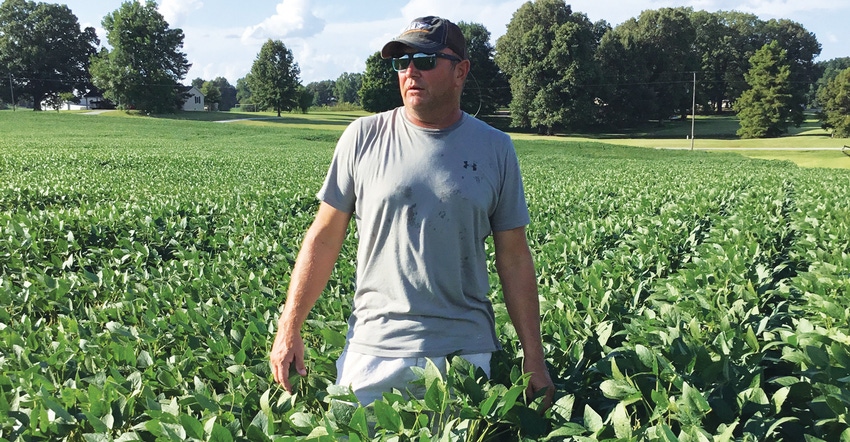
Hunter Hooper’s 2021 soybean crop is promising but needs a bit more rain.
“We’re just a couple of rains away from having a good crop,” he said.
“It’s hot and dry at the moment,” Hooper said in early August of his Haywood County, Tenn., farm. “But the crop looks pretty good. It might not be the best we’ve seen in the last few years, but with prices where they are it doesn’t have to be the best. The market looks a lot better than last summer.”
Making certain he has the best odds of making good yields depends on several factors, Hooper said. Key among those are the right crop mix, the right rotation and putting the right varieties on the right ground.
He’s off to a good start this year with “the best wheat crop ever,” harvested in early summer. “Yield topped 100 bushels per acre,” he said. “I planted a lot, 1,700 acres, the most I ever planted, and made the best yield and had the best market ever. That rarely happens.”
Hooper expects to cut a few soybeans by late September and expects three new varieties to do well.
Asgrow Xtendflex
He planted 2,000 acres in three new Asgrow varieties — AG42XFO, AG47XFO, and AG48XFO. “We need the XtendFlex trait for weed control,” Hooper said. “With the cutoff date for dicamba, we have no window to apply it, on doublecrop soybeans. These new varieties offer the best option to control weeds in doublecrop beans.”
He says glyphosate-resistant pigweed is his worst weed problem. “We have other troublesome weeds, but resistant pigweed is the worst.”
He saw the Asgrow XtendFlex soybean varieties on small plots last year. “They looked as good, if not better than what I had been planting. I planted 2,000 acres this year; next year I’ll plant all XtendFlex.
“They all look good, so far,” he said. “Everything looks good. I expect to cut a few beans at the end of September but will harvest most of them in October.”
He says he planted in three separate stages. “I planted about 800 acres of soybeans before I planted corn. I planted 1,700 acres doublecrop behind wheat. I planted the rest at the normal time, mid-May.”
Variety selection crucial
Hooper says variety (or hybrid) selection is a crucial factor in crop yields.
“Choosing varieties,” he said, “includes working with the seed company rep; also important is looking at previous years’ test results. Many new varieties I try come from parent lines I’ve used before that performed well.
“Variety selection is a little of everything,” he adds. “I’m checking fields now, looking at characteristics, stands, plant height.”
He looks at on-farm variety trials, too, some on his own land.
“I plant trials every year, sometimes beans and corn, sometime just corn. It’s just corn this year.
“It’s important to know the ground,” he added. “On some fields, I don’t want plants to get too tall. I look at what I can irrigate and stack nodes. I look at disease packages.”
Hooper said about 25% of planted acreage is a reasonable figure to plant a new variety on the first year. He might go higher.
“This year, I planted quite a bit of new soybean varieties, and all of the doublecrop acres. I’m not afraid to put half a crop into new varieties,” he added. “Seed companies seldom advance something that’s not better than the products they replace.
“New varieties come out fast to replace older ones. Back in the day, when we grew cotton, we planted only Deltapine 50 for years.”
Company rep important
He says working with a good rep also makes a big difference. I have worked with the same rep, Ross Bradley, for the last 12 years. I have confidence in him. Ross knows my farm; he knows what works. It’s the same with corn. Placing the right hybrid or variety on the right ground is crucial.”
He said confidence extends to suppliers, too. “I’ve been buying seed from the same retailer for 20 plus years.”
Rotation plays an important role in his crop mix. He plants corn, soybeans, and wheat.
“On hill ground, I try to follow corn with wheat and then beans. On flat ground, I stay with corn and beans.”
Tillage reduced
He says his tillage practices have changed dramatically since he started farming with his father back in 1995. “I minimum till most everything except doublecrop soybeans. I no-till those. Growing up, we made five tillage strips. This is a big change.”
He said bigger equipment and high-speed planters improve efficiency. “We can plant 300 acres a day with one 40-foot high-speed planter.”
He irrigates 25% of his 5,000-acre operation. “We have limited space for irrigation,” he said. “It’s hilly, so there is only so much we can do.”
He had cover crops on 600 acres last year. “I follow a heavy wheat rotation, so I plant less cover. The cover crop and the residue from wheat, corn and soybeans help build organic matter. Also, these three crops help with weed control, offering multiple herbicide options.”
Harvest
He expects to start harvesting corn the first or second week in September. “We’re a little behind; we planted a little later because corn seems to do better when we don’t plant in that cold window.”
Hooper says the grain operation offers him the best opportunity to make profits. “I grew up a cotton farmer,” he said. “We had a little grain in the corners, but in the 2000s I started moving more and more to grains.”
Hooper farmed with this father from 1995 to 1998. “I’ve been on my own since 1999, started out working 1,000 to 1,200 acres. I’m farming 5,000 now.”
Staying efficient, he said, means taking advantage of better equipment, years of experience and varieties that offer flexibility to produce good yields efficiently.
About the Author(s)
You May Also Like






